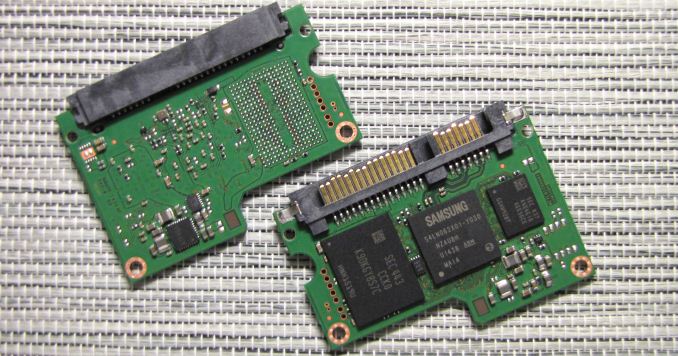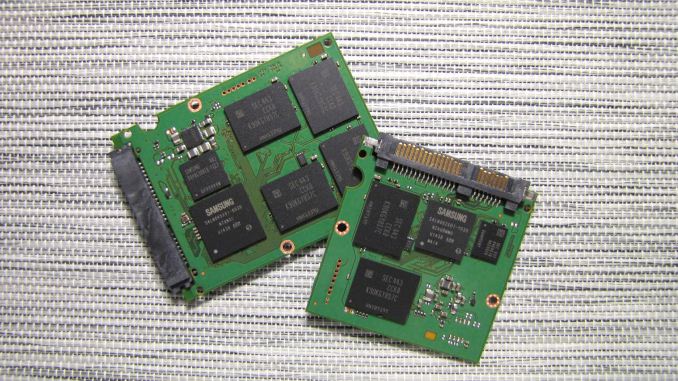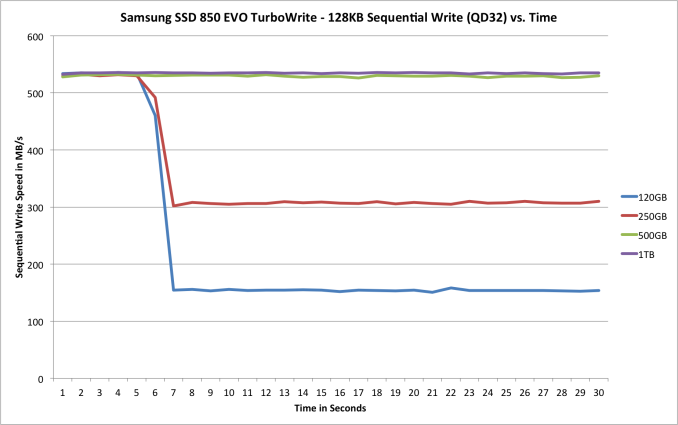Samsung SSD 850 EVO (120GB, 250GB, 500GB & 1TB) Review
by Kristian Vättö on December 8, 2014 10:00 AM ESTInside The Drives
There are three different PCB designs in the 850 EVO lineup. The 120GB and 250GB models (above) use a tiny PCB with room for two NAND packages (one on each side). Interestingly enough, both use octal-die packages, meaning that the 120GB 850 EVO only has a single 128GB (8*16GB) NAND package. Decoding the part number reveals that the packages are equipped with eight chip enablers (CEs), so a single NAND package is viable since all eight dies can be accessed simultaneously.
The use of octal-die packages is actually true for all capacities. It's an interesting choice nevertheless, but I suspect Samsung's packaging technology is advanced and mature enough that it's more cost efficient to use high die count packages and small PCBs instead of larger PCBs with more and less dense NAND packages.
| Samsung SSD 850 EVO NAND Configurations | ||||
| Capacity | 120GB | 250GB | 500GB | 1TB |
| # of NAND Packages | 1 | 2 | 4 | 8 |
| # of Die Per Package | 8 | 8 | 8 | 8 |
| Total # of Die | 8 | 16 | 32 | 64 |
| Die Capacity | 128Gbit | 128Gbit | 128Gbit | 128Gbit |
| Raw NAND Capacity | 128GiB | 256GiB | 512GiB | 1024GiB |
| Over-Provisioning | 12.7% | 9.1% | 9.1% | 9.1% |
TurboWrite
TurboWrite is a feature that Samsung brought to the 840 EVO to increase write performance. The idea of running a small portion of the NAND in SLC mode was nothing new, but it was the first time it truly made sense because the 840 EVO used slower TLC NAND and hence the SLC buffer could provide significant improvements to write performance and user experience. Unsurprisingly, TurboWrite is also present in the 850 EVO.
| Samsung SSD 850 EVO TurboWrite SLC Buffer Size | ||||
| Capacity | 120GB | 250GB | 500GB | 1TB |
| TurboWrite Buffer Size | 3GB | 3GB | 6GB | 12GB |
The buffer sizes and core architecture have remained unchanged. All writes hit the SLC buffer first, from which they then get moved to the TLC array during idle time. The only exception is a case of long, sustained period of writes that exceeds the buffer size, in which case the data will be written straight to the TLC portion.
| Write Performance With and Without TurboWrite | ||||
| With TurboWrite | Without TurboWrite | |||
| Sequential Write | 4KB Random Write (QD32) | Sequential Write | 4KB Random Write (QD32) | |
| 120GB | 520MB/s | 88K IOPS | 150MB/s | 38K IOPS |
| 250GB | 520MB/s | 88K IOPS | 300MB/s | 70K IOPS |
| 500GB | 520MB/s | 90K IOPS | 500MB/s | 80K IOPS |
| 1TB | 520MB/s | 90K IOPS | 520MB/s | 80K IOPS |
Samsung's reviewer's guide states that the 850 EVO features "enhanced TurboWrite technology" with a focus on random write performance, but I don't have any additional details as to how the TurboWrite implementation in the 850 EVO differs from the 840 EVO. TurboWrite was always designed to cache all writes regardless of the nature of the write (random vs sequential), so I'm not sure if anything has actually changed. Obviously the algorithms have been optimized for the new NAND and controller architecture and it's possible that the whole batch of algorithms has improved in the process, but I'll provide an update when I hear back from Samsung.
I ran a quick sequential write test to see how TurboWrite behaves in the 850 EVO. At smaller capacities it clearly provides a tremendous performance boost, but at 500GB and 1TB there is enough NAND to provide the parallelism that is needed to max out the SATA 6Gbps interface. That is a big improvement over the 840 EVO as its write performance maxed out at ~400MB/s when writing to the TLC array, so the performance benefits of 3D NAND technology are already evident.













97 Comments
View All Comments
KAlmquist - Monday, December 8, 2014 - link
My guess is that Samsung doesn't have the ability to produce very much V-NAND. So the 850 PRO, and now the 850 EVO, are priced to encourage most people to choose SSD's from the 840 line rather than the 850 line, preventing demand for the 850 line from exceeding the supply.rms141 - Monday, December 8, 2014 - link
The absence of the Samsung 840 Pro from the Storage Bench 2013 section is pretty odd. Why wouldn't you include the previous generation's higher performing product? This is a little bit like publishing a GTX 970 review without including the GTX 780 for reference.Kristian Vättö - Tuesday, December 9, 2014 - link
You can always use the Bench tool to compare any and all drives that we have tested over the years:http://www.anandtech.com/bench/SSD/65
fokka - Monday, December 8, 2014 - link
it doesn't make much sense to complain about the msrp when the drive is just now trickling to retailers. you're probably not gonna make a good deal on a 850 evo before christmas, but the prices will come down considerably in q1/q2 2015, they always do.that said, i wouldn't mind paying a couple bucks more for a 850, compared to a 840, since it's just the all around better drive and it's lower power consumption alone makes it the better option for laptops.
pitted against an mx100 it might be a tougher sell, but let's just wait a bit for the prices to come down and give the early adopters some time to beta-test the firmware for us in the meantime.
Morawka - Tuesday, December 9, 2014 - link
Does TurboWrite, native encryption, and TRIM work in RAID 0 on the 850 EVO? Thats the only way i would invest $500+ into a SSD still bottlenecked by Sata 6hojnikb - Tuesday, December 9, 2014 - link
All of that should work with appropriate motherboard/storage drives, because drive itself is not aware whenever is in RAID or not.hojnikb - Tuesday, December 9, 2014 - link
*driverspaesan - Tuesday, December 9, 2014 - link
I just got a 1TB 840 evo for $369. No way the 850 evo is worth the extra $100.R3MF - Tuesday, December 9, 2014 - link
How do you conduct this review of a perfomance oriented SSD without discussing:1. m.2 format (or lack thereof)?
2. PCIe 3.0 4x m.2 performance (vs SATA 6G)?
3. NVME m.2 performance (vs SATA 6G)?
It is the end of 2014, who seriously spends £320 on a 1TB performance SSD without considering the high-speed m.2 drives just around the corner, to which a growing number of enthusiasts have empty slots on their shiny new motherboards?
hojnikb - Tuesday, December 9, 2014 - link
>How do you conduct this review of a perfomance oriented SSD without discussing:EVO is not a performance oriented drive. 850PRO is. And this was already discussed in other reviews/seperate articles.